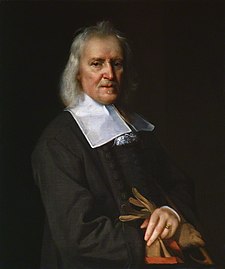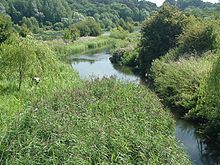Izaak Walton
From Wikipedia, the free encyclopedia
| This article needs additional citations for verification. (June 2013) |
| Izaak Walton | |
|---|---|

portrait of Walton by Jacob Huysmans
|
|
| Born | unknown,[1] c. 1594 Stafford, England |
| Died | 15 December 1683 Winchester, England |
| Residence | Shallowford, Staffordshire |
| Known for | Authoring The Compleat Angler |
| Spouse(s) | Rachel Floud (married 1626–1640) Anne Ken (1641?–1662) |

Walton's house at '120 Chancery Lane' occupied 1627–1644 (from Old & New London, Walter Thornbury, 1872)
Contents
Biography
Walton was born at Stafford c. 1594; the traditional '9 August 1593' date is based on a misinterpretation of his will, which he began on 9 August 1683.[1] The register of his baptism gives his father's name as Gervase. His father, who was an innkeeper as well as a landlord of a tavern, died before Izaak was three. His mother then married another innkeeper by the name of Bourne, who would later run the Swan in Stafford.He settled in London where he began trading as an ironmonger in a small shop in the upper storey of Thomas Gresham's Royal Burse or Exchange in Cornhill. In 1614 he had a shop in Fleet Street, two doors west of Chancery Lane in the parish of St Dunstan's.[2] He became verger and churchwarden of the church, and a friend of the vicar, John Donne.[1] He joined the Ironmongers' Company in November 1618.[1]
Walton's first wife was Rachel Floud (married December 1626), a great-great-niece of Archbishop Cranmer. She died in 1640. He soon remarried, to Anne Ken (1646–1662), who appears as the pastoral Kenna of The Angler's Wish; she was a stepsister of Thomas Ken, afterwards bishop of Bath and Wells.
After the Royalist defeat at Marston Moor in 1644, Walton retired from his trade. He went to live just north of his birthplace, at a spot between the town of Stafford and the town of Stone, where he had bought some land edged by a small river. His new land at Shallowford included a farm, and a parcel of land; however by 1650 he was living in Clerkenwell, London. The first edition of his book The Compleat Angler was published in 1653. His second wife died in 1662, and was buried in Worcester Cathedral, where there is a monument to her memory. One of his daughters married Dr Hawkins, a prebendary of Winchester.
The last forty years of his life were spent visiting eminent clergymen and others who enjoyed fishing, compiling the biographies of people he liked, and collecting information for the Compleat Angler. After 1662 he found a home at Farnham Castle with George Morley, bishop of Winchester, to whom he dedicated his Life of George Herbert and his biography of Richard Hooker. He sometimes visited Charles Cotton in his fishing house on the Dove.
Walton died in his daughter's house at Winchester, and was buried in Winchester Cathedral.[3]
Walton's cottage at Shallowford

Photogravure of Walton's Shallowford house, 1888
In 1837 the Grand Junction Railway was built across the land to the west, cutting the buildings off from part of the river. The farm and the cottage became derelict but continued to be tenanted until 1920 when the property was offered for sale. Local Stafford businessmen formed The Izaak Walton Cottage Trust to establish a small museum dedicated to the famous writer. They raised £50 to purchase the site and £500 to repair the cottage. Lord Stafford ceremonially opened the museum on 30 April 1924. In 1927 sparks from a steam train caused a fire that destroyed the thatched roof, and the museum was closed for a year. There was another fire in 1938, and in 1939 the cottage re-opened with a tiled roof. The Trust wound up in 1965, and the building was taken over by Stafford Borough Council. During the 1990s the thatched roof was restored. The ground floor of the museum is set-out in period, with information boards covering Walton's life, his writings and the story of the Izaak Walton Cottage. Upstairs a collection of fishing related items is displayed, the earliest dating from the mid-eighteenth century, while a room is dedicated to his Lives and The Compleat Angler. The Izaak Walton Cottage and gardens are open to the public on Sunday afternoons during the summer.[4]
The Compleat Angler

Viator's bridge near Milldale (Peak District) is named for its reference in The Compleat Angler
Walton did not profess to be an expert with a fishing fly; the fly fishing in his first edition was contributed by Thomas Barker, a retired cook and humorist, who produced a treatise of his own in 1659; but in the use of the live worm, the grasshopper and the frog "Piscator" himself could speak as a master. The famous passage about the frog, often misquoted as being about the worm—"use him as though you loved him, that is, harm him as little as you may possibly, that he may live the longer"—appears in the original edition. The additions made as the work grew did not affect the technical part alone; quotations, new turns of phrase, songs, poems and anecdotes were introduced as if the author, who wrote it as a recreation, had kept it constantly in his mind and talked it over point by point with his many friends. There were originally only two interlocutors in the opening scene, "Piscator" and "Viator"; but in the second edition, as if in answer to an objection that "Piscator" had it too much in his own way in praise of angling, he introduced the falconer, "Auceps," changed "Viator" into "Venator" and made the new companions each dilate on the joys of his favourite sport.
The best-known old edition of the Angler is J. Major's (2nd ed., 1824). The book was edited by Andrew Lang in 1896, followed by many other editions.
Walton's Lives
The full title of Walton's book of short biographies is Lives of John Donne, Henry Wotton, Rich'd Hooker, George Herbert, &C. His leisurely labours as a biographer seem to have grown out of his devotion to angling. It was probably as an angler that he made the acquaintance of Sir Henry Wotton, but it is clear that Walton had more than a love of fishing and a humorous temper to recommend him to the friendship of the accomplished ambassador. At any rate, Wotton, who had intended to write the life of John Donne, and had already corresponded with Walton on the subject, left the task to him. Walton had already contributed an Elegy to the 1633 edition of Donne’s poems, and he completed and published the life, much to the satisfaction of the most learned critics, in 1640. Sir Henry Wotton dying in 1639, Walton undertook his life also; it was finished in 1642 and published in 1651. His life of Hooker was published in 1662, that of George Herbert in 1670 and that of Bishop Robert Sanderson in 1678. All these subjects were endeared to the biographer by a certain gentleness of disposition and cheerful piety; three of them at least—Donne, Wotton and Herbert—were anglers. Their lives were evidently written with loving pains, in the same leisurely fashion as his Angler, and like it are of value less as exact knowledge than as pictures of character.Other literary works
- Sir John Skeffington
- John Chalkhill
- Waltoniana — an 1878 collection of Walton's poems and prose fragments
Walton in literature
Walton has appeared in a number of works of literature.Non-fiction
Charles Lamb, in his letter to Samuel Taylor Coleridge, recommends the Compleat Angler: "It breathes the very spirit of innocence, purity, and simplicity of the heart. There are many choice old verses interspersed in it; it would sweeten a man's temper at any time to read it; it would Christianise every discordant angry passion; pray make yourself acquainted with it." Washington Irving's humorous essay The Angler comments on Walton's popularity; the work is in The Sketch Book of Geoffrey Crayon, Gent.. Gilbert Ryle uses him in his 1949 book The Concept of Mind as an example of "'knowing how' before 'knowing that'".Fiction
Nineteenth century
Charles Dickens uses the name Izaak Walton in A Tale of Two Cities to develop an extended metaphor comparing Jerry Cruncher's night-time "occupation" of grave robbing to fishing. Walton is mentioned in Jules Verne's classic The Mysterious Island when the castaways decide to use snares to catch birds: "He took Herbert to some distance from the nests, and there prepared his singular apparatus with all the care which a disciple of Izaak Walton would have used." Walton is mentioned by Thomas Hardy in his 1891 A Group of Noble Dames where his relation to fish is compared to the relation of the Petrick family towards the aristocracy.Twentieth century
Zane Grey uses the name Izaak Walton in Betty Zane in a fishing story: Alfred Clarke said "I never knew one (girl) who cared for fishing." Betty Zane answered, "Now you behold one. I love dear old Izaak Walton. Of course you (Clarke) have read his books?"[5] Jess Mowry mentions Izaak Walton in his novel, Knights Crossing where an educated slave describes his master as "a disciple of Izaak Walton." Walton is the protagonist of Howard Waldrop's short story "God's Hooks!" (1982). In the best selling semi-autobiographical novel The River Why (1983) by David James Duncan, The Compleat Angler serves as the most revered book in the irreverent fly fisherman Gus Orviston's childhood home, his parents quoting and misquoting Walton as they obsessively argue their respective sides of the artificial fly versus natural bait controversy. Walton appears as "Piscator" in the novel Silverlock by John Myers Myers and under his own name in the novel Conceit by Mary Novik. Walton comes under fire in Norman Maclean's short story A River Runs Through It, later filmed under the same name. Ben Bova has a character named "Isaac Walton" in The Precipice, the first book of the Asteroid Wars, where it is joked that he came to the Moon to escape fishing jokes. Donna Tartt's novel The Secret History has the character Bunny erroneously linking Walton and John Donne in his imaginary belief in "metahemeralism".In film
In the 1946 thriller Terror by Night, Sherlock Holmes (Basil Rathbone), about to board a train, encounters Inspector Lestrade (Dennis Hoey) on the same train, ready to presumably go on a vacation, and loaded down with fishing gear. He later tells Dr. Watson (Nigel Bruce) that Lestrade is on the train "giving an excellent imitation of Izaak Walton". Lars Von Trier entitled the first chapter of his "Nymphomaniac" (2013) "The Compleat Angler" and used Walton's text as the source of his first digression in the film.Walton is also referenced by name in the 1939 W.C. Fields film You Can't Cheat an Honest Man. During a comedic ping-pong game, the ball gets trapped in a table fan's air current pointing upwards. Fields' response to the ball leaping up and down is "Shades of Izaak Walton."


No comments:
Post a Comment
Please leave a comment-- or suggestions, particularly of topics and places you'd like to see covered